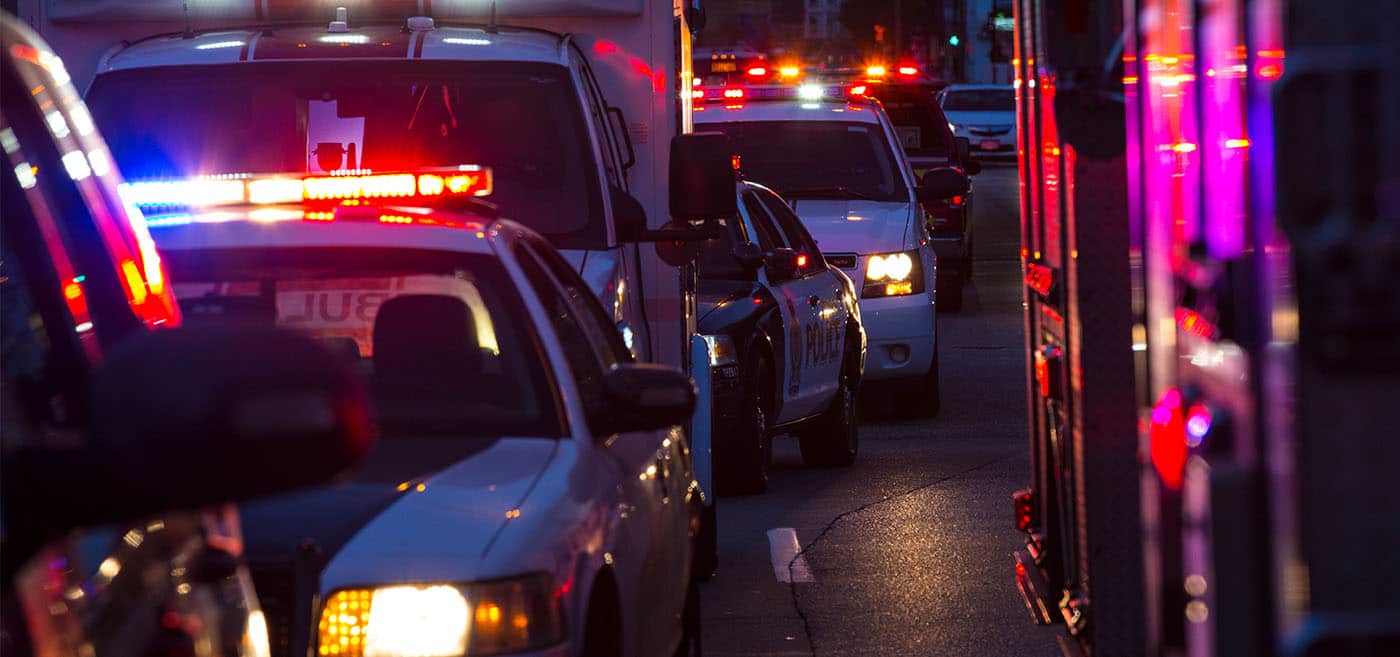In today’s connected world, police officers, fire fighters, paramedics, and other first responders use a wide variety of connected mobile solutions to communicate with colleagues, collect and view critical data, and gain the situational awareness they need to better protect their communities.
For example, if you look into a police officer’s car today you are likely to find a vehicle router connecting various in-car mobile solutions -- a laptop that the officer uses to access Computer Aided Dispatch (CAD) and other applications, video cameras, a DVR, an Automated License Plate Recognition (ALPR) system, a Land Mobile Radio (LMR), and vehicle telemetry or engine diagnostics systems -- to the internet via a secure Virtual Private Network (VPN). Meanwhile, the officer will often carry with them other connected mobile solutions like a body camera, an e-ticketing device, a hand-held radio, a tablet and a cell phone -- all of which also use the Vehicle Area Network (VAN) created by their vehicle’s router to transmit data to and from headquarters.
Recent research confirms the fact that public safety agencies are increasingly adopting connected mobile solutions like these. A 2020 U.S. Law Enforcement Survey conducted by Motorola found that 75% of law enforcement agencies are currently using in-car cameras, 68% are using body-worn cameras, and 36% are using ALPR systems. This adoption of mobile solutions is not likely to slow down, as 93% of these agencies say they plan to use in-car cameras by 2023, while 96% plan to use body-worn cameras and 75% plan to use ALPR systems.
While these and other connected mobile solutions vary greatly in how they are used by first responders, they do share one thing in common – they require secure, fast, reliable, and affordable mobile connectivity. However, many public safety agencies have struggled to cost-effectively deliver their first responders the mission-critical connectivity required to maximize the value of these mobile solutions.
Some examples of these mobile connectivity challenges include:
● Difficulties Offloading Video: Video from police officers’ body and in-car cameras needs to be transferred to their police department’s video management system for long-term storage. Some police officers need to take their body cameras or in-car camera video storage systems physically out of their vehicle and into the station to offload video to the department’s video management system. Other times, they have to use in-station Wi-Fi connections to transmit video from these cameras to the video management system. This can lead to officers spending hours per week at the vehicle depot offloading video. In rural areas, it can force police officers to drive their take-home police vehicle to a location where they can physically remove the camera storage system for video offloading, or to a secure Wi-Fi network where they can transmit their body or in-car camera video to their department’s video management system.
● Limited Access to Real-Time Video: Public safety agencies often lack the broadband mobile connectivity required to live-stream vehicle dash camera video from frontline officers to the command center. Without access to real-time video, these command officers are “blind” and can only rely on voice communications from their frontline officers as they make life or death decisions on how to advise and support these officers.
● Inefficient Radio Fleet Management: If public safety agencies’ radio managers want to add or remove channels from their radios or upgrade the radios’ firmware, they have to spend hours physically collecting them from their users and then manually updating each radio individually, significantly increasing radio management costs.
● LMR Coverage Gaps: Emergencies and other activities can take first responders to remote areas or other locations outside of their agencies’ LMR coverage area. This can result in first responders not being able to use their radios when reliable communications are needed most.
Motorola and Sierra Wireless have partnered to address these and other mobile connectivity challenges by ensuring Motorola radios, body cameras, in-car cameras, ALPR systems, and other connected mobile solutions work seamlessly with Sierra Wireless’ multi-network vehicle routers. Together, Motorola and Sierra Wireless offer public safety agencies the ‘always-on’ mobile connectivity they need to transform how they serve their communities.
Improved Video Offloading and New Video Streaming Capabilities
One area where Motorola and Sierra Wireless have partnered to overcome public safety agencies’ mobile connectivity challenges is in the development of solutions for collecting, streaming, and offloading video from body-worn and in-car video cameras.
These vehicle connectivity solutions enable police departments to use Sierra Wireless’ Airlink® MG90 and MP70 high performance vehicle routers to offload video from their Motorola WatchGuard V300 body-worn cameras and 4RE in-car video cameras over both high-speed LTE cellular networks in the field and Wi-Fi networks at the police station. By using a mobile-optimized Federal Information Processing Standards (FIPS)-compliant VPN like the Airlink Connection Manager, these police departments can offload this video in a secure manner that preserves the video’s chain of custody, all while the officer performs his duties throughout the day.
This allows police officers to spend more time on the front lines rather than in the station offloading video. Officers no longer need to make a trip to the station or find a secure Wi-Fi network to offload video from their take-home vehicles. As they describe in this video, the Arkansas Highway Police is one of those agencies using Sierra Wireless MP70 vehicle routers and Motorola's WatchGuard cameras to reduce the time their offices spend offloading video.
At the same time, Sierra Wireless and Motorola offer police departments vehicle connectivity solutions that can stream live video from body-worn and in-car video cameras to the department’s control center even when officers are in the field. Protected with end-to-end FIPS encryption, this live video stream can be activated by auxiliary device monitoring that alerts command officers to look-in on their front-line officers’ situation if, for example, these officers turn on their sirens, draw their guns, or activate the emergency button on their APX radio. By providing command officers with better situational awareness, live-video streams enable officers to offer better guidance and support to their frontline officers.
Easier Radio Fleet Management and Better Radio Coverage
Sierra Wireless and Motorola have also partnered to develop vehicle connectivity solutions that help public safety agencies lower radio management costs while extending LMR coverage. With these solutions public safety department radio managers can configure and update the software in first responders’ Motorola’s APX portable and mobile radios using Sierra Wireless vehicle routers. Radio managers can remotely send firmware updates to these radios, change their channels, and make other changes to them via the secure wireless connection. The result is quicker updates, lower radio downtime, and less time spent by frontline first responders bringing their radios into the shop to be reprogrammed or otherwise updated.
Sierra Wireless multi-network vehicle routers, along with Motorola’s Smart Connect solution, also help public safety agencies extend the range of their radios. With Motorola’s SmartConnect feature, if a public safety agency’s APX portable or mobile radio goes out of range of the LMR network, it can use a Sierra Wireless vehicle router’s multi-network capabilities to seamlessly switch over to an LTE or satellite network for encrypted transmission of voice to the agency’s Motorola ASTRO 25 LMR Core system. This vehicle connectivity solution allows first responders to use their radios nationwide, with cellular or even satellite coverage in remote locations and other areas where their agency’s LMR network does not provide coverage.
Partnering to Enhance Public Safety Agencies’ Mobile Communications
As the above examples demonstrate, Motorola and Sierra Wireless’ partnership offers public safety agencies vehicle connectivity solutions that allow them to improve the effectiveness and lower the cost of their video and voice communications. Together, we are working to extend this partnership, exploring ways to use 5G and other new technologies to further increase the effectiveness and reliability of first responders’ connected mobile solutions, while lowering the deployment and management costs associated with them.
Listen to our joint webinar, Connected Mobile Solutions: Transforming Public Safety Agencies, to learn more about how Sierra Wireless and Motorola have teamed up to provide public safety agencies with cost-effective vehicle connectivity solutions that allow them to transform how they protect the health and safety of their communities.

